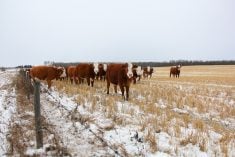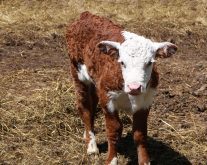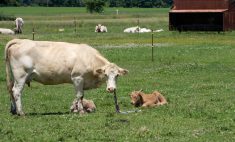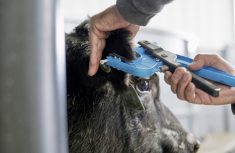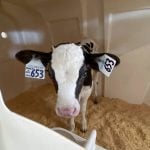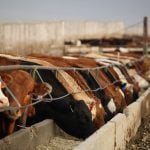Scours. It should be a four-lettered word, for all the misery it causes on cow-calf operations. Even with the best preventative practices, outbreaks can pop up in herds. And in the middle of an outbreak, the focus is on survival, for calves and humans alike.
During an outbreak, producers are generally going to see a “spectrum of disease,” says Dr. Claire Windeyer, calf health researcher at the University of Calgary’s faculty of veterinary medicine. Calves facing life-threatening illness may be extremely dehydrated, “down and out,” and not drinking or sucking, she adds. Other calves in the same herd may have a bit of loose manure for a day or two, and suck a little less, but otherwise seem fine.
Sometimes an outbreak can be slow to start. But as the calving season progresses, and calf numbers increase, the number of sick calves may also rise. Add the wrong kind of weather, and you may have a wreck on your hands.
Read Also

Building demand together: The impact of Canada’s beef import levy
The beef import levy has become a central tool for ensuring balance in Canada’s beef industry
Windeyer says their research shows on average, about three per cent of calves are treated for scours each year. But on a specific farm, the treatment rate can range from zero to over 10 per cent. Once the rate hits 10 per cent, you’ve got an outbreak on your hands. Losses vary, too, depending on which pathogen is causing the scours and whether the producer is able to get a handle on it.
“You can see zero losses even though you’ve got a lot of sick calves, or you can have only a few calves but all of them die depending on what’s going on.”
Treatment
Whatever the bug behind the disease, the key to keeping calves alive is keeping them hydrated, and that means administering oral electrolytes.
“I know people don’t always love trying to chase calves around and get fluids into them. It’s not an easy chore, but I think what people don’t always recognize is calves don’t die from diarrhea. They die from dehydration.”
Generally, if you can catch the calf, it probably still needs treatment, says Windeyer, although it depends a bit on the herd. Colostrum is great for preventing scours, but usually by the time a calf is sick, it’s too late for colostrum’s immunity boost. The goal is to treat the calf with oral electrolytes before it’s so down and out that it needs a vet visit, to administer IV fluids.
Not all oral electrolytes are created equal, says Windeyer. She suggests talking to your vet before calving season starts and having the right kind of electrolytes on hand, as Murphy’s Law dictates things will likely escalate on a Sunday night instead of a Tuesday morning.
Another adage that applies to scours is “dilution is the solution to pollution.”
“Whatever we can do to get newborn calves away from sick or even just healthy older calves is really critical.”
Planning ahead with an approach such as the Sand Hills system is great, but producers can also improve things mid-outbreak. Think about a clean place to move animals in case of an outbreak. Fresh pasture or fresh bedding is key.
“I’ve seen people stop scours outbreaks in their tracks just by moving the calving cows into a fresh pasture.”
Whether or not a calf needs antibiotics depends largely on the bugs involved. Most cases of scours are caused by parasites or viruses, and antibiotics don’t target those pathogens.
Calves at risk of septicemia are a different story. In these cases, bacteria that normally live in the gut escape through a leaky gut wall. Bacteria then enter the bloodstream, triggering inflammation through the whole body, Windeyer says. These calves do need antibiotics.
Septic calves are usually “super, super sick,” she says. Signs of sepsis include red gums, bloodshot eyes and blood in the manure. The calf may be unable to regulate its body temperature, and either suffer from fever or cold.
Some pathogens such as cryptosporidium and coccidiosis can be treated with specific drugs. But in general, it comes down to fluids, says Windeyer.
Beware “vet flu”
One type of scours is sometimes referred to as the “vet flu” or “vet student diarrhea.” Cryptosporidium, or crypto, is a parasite that can infect people as well as cattle. Windeyer says it’s common, especially in people who haven’t spent a lot of time around cattle. For example, family members from the city who help out with calving on weekends can be at risk. So can kids, elderly people and anyone who’s immune compromised, says Windeyer.
Sometimes crypto is diagnosed after the people get sick. “And because we don’t often know what’s causing the scours in our calves when we’re in the middle of an outbreak, I think it’s important to treat every scouring calf like they might make people sick.”
Keeping the vet flu out of the house comes down to hygiene. Washing hands well with hot, soapy water after touching a scouring calf is the number one preventative measure, says Windeyer. If producers don’t have water in the barn, wearing gloves can help. Wearing specific clothing, such as coveralls, when handling scouring calves can also help contain the crypto. Think about potential contamination of other clothing such as hats or toques, and if you have long hair, tie it back.
“You don’t necessarily think about it. But if you get a little bit of manure in your hair and then your hair blows in your face — it can happen.”
Finally, keep at-risk people away from scouring calves. While it’s tempting to have the kids bottle-feed the sick calf, that’s something to avoid, says Windeyer.
“They can watch but maybe not handle those sick calves.”
Next year country
In the middle of a scours outbreak, the focus is on surviving the calving season. But once it’s time to think about preventing an outbreak the next year, it’s helpful to know which bug was plaguing the calves.
Producers can call the vet to autopsy calves in the field or send a calf in to a diagnostic lab. They can also collect fresh fecal samples from calves, but which calves they select, and when, is key to getting an accurate diagnosis.
“Usually, we want the ones who are just breaking with scours and haven’t been treated with any antibiotics or anything yet. Those are going to be the most diagnostically helpful.”
Because scours is a multifactorial disease, meaning several things are likely affecting a calf at once, it’s best to sample from more than one calf. Choose several calves in the early stages of the disease, she says.
A pencil and paper, or their digital counterparts, also help. Recording the ages of calves when they were treated, and treatment dates, provides clues, even without diagnostics, says Windeyer. Different pathogens affect calves at different ages and exhibit different patterns as they spread through the herd, she adds.
“So just some basic record-keeping can be quite useful in addition to doing some diagnostics if you have the chance.”
Producers can also consider vaccinating for E. coli, rotavirus and coronavirus.
Pasture management is another consideration.
“I know it’s hard because usually you’ve got the space you’ve got, but thinking about how to best use that space during calving and even when you bring the cows home to the calving pasture can make a difference.”
Consider factors such as bedding and shelter, and the hygiene of those spaces. Think about feeding in different areas throughout the calving season, to spread out the herd. And finally, make sure there’s a plan to get calves the colostrum they need early on, if they’re not sucking on their own.
“I think one of the big challenges with scours is sometimes it can feel like a game of whack-a-mole because it’s a multifactorial disease. Lots of different things can be happening that cause it and it’s usually pretty complicated.”
It’s not unusual for a producer to see the same problem pop up a few years after they thought they’d fixed it. Windeyer recommends talking to a vet so they can help “figure out which mole to whack.”
A vet can help figure out “where your vulnerabilities are with your management and what strategies you can use to try and mitigate the problem.”





